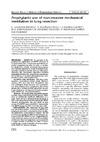Identificador persistente para citar o vincular este elemento:
https://accedacris.ulpgc.es/jspui/handle/10553/41807
| Título: | Prophylactic use of non-invasive mechanical ventilation in lung resection | Autores/as: | Guerra Hernández, E. Rodríguez Pérez, Aurelio Freixinet Gilard, J. Martín Álamo, M. N. Escudero Socorro, M. Rodríguez Suárez, P. Esquinas, A. M. |
Clasificación UNESCO: | 321303 Anestesiología 320508 Enfermedades pulmonares |
Palabras clave: | Noninvasive ventilation BiPAP Thoracic surgery Gas exchange Prophylactic noninvasive ventilation |
Fecha de publicación: | 2018 | Publicación seriada: | European Review for Medical and Pharmacological Sciences | Resumen: | OBJECTIVE: To evaluate if the prophylactic application of BiPAP previous to lung resection and 17 hours postoperatively improves respiratory function. In order to do this, we studied the results of arterial blood gases and portable spirometry in the immediate postoperative period and at the first and third postoperative day. Secondary objectives included evaluating whether this same pattern decreases the incidence of postoperative pulmonary complications (PPC) and hospital stay. PATIENTS AND METHODS: This was a prospective, randomized clinical study. Between January 2012 and June 2013, 50 patients who had undergone lung resection with posterolateral thoracotomy were assigned to one of two groups by a random number generator according to whether or not they would receive prophylactic BiPAP pre- and postoperatively. RESULTS: The results of the gasometric and spirometric values were similar in both groups. There were no statistically significant differences (p > 0.05). There was not a decrease in the incidence of PPC in the group that received prophylactic BiPAP. Likewise, postoperative stay was similar in both groups. The BiPAP group was 6.60 ± 4 days and the non BiPAP group was 6.84 ± 3.94 days (p = 0.63). CONCLUSIONS: One drawback of this work was the limited number of hours that BiPAP was employed, and when compared to other studies, the application of low-pressure support. We did not find any significant differences between using prophylactic BiPAP or not, suggesting that such treatment should not be performed indiscriminately. More investigations are needed with a larger number of patients in order to better evaluate the possible benefits of using prophylactic BiPAP in thoracic surgery. | URI: | https://accedacris.ulpgc.es/handle/10553/41807 | ISSN: | 1128-3602 | DOI: | 10.26355/eurrev-201801-14117 | Fuente: | European Review for Medical and Pharmacological Sciences [ISSN 1128-3602], v. 22 (1), p. 190-198, (Enero 2018) |
| Colección: | Artículos |
Citas SCOPUSTM
6
actualizado el 08-jun-2025
Citas de WEB OF SCIENCETM
Citations
2
actualizado el 25-feb-2024
Visitas
116
actualizado el 03-ago-2024
Descargas
54
actualizado el 03-ago-2024
Google ScholarTM
Verifica
Altmetric
Comparte
Exporta metadatos
Los elementos en ULPGC accedaCRIS están protegidos por derechos de autor con todos los derechos reservados, a menos que se indique lo contrario.
